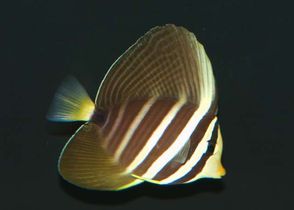Sailfin Tang
- Species Information

Zebrasomas veliferum
The Sailfin tang, Zebrasomas veliferum (Bloch, 1795) while not rare in the trade, is not as commonly available as some other species of tangs, such as the yellow tang and blue tang. Its beautiful, unique coloration sets this fish apart from others, with the exception of the Desjardini Sailfin tang with which it is often confused. With its impressive size and active nature, this fish is sure to be a centerpiece in any home aquarium. Because of their size, they require a very large tank with live sand, rockwork for grazing, and plenty of swimming space. In the wild these tangs consume mostly micro and macro algae and require Nori daily to get enough vegetable matter. In addition, we feed Sailfin tangs our hatchery diet, Spirulina brine, and mysis when raising them at our Sustainable Islands project. Being a large omnivore, these fish have voracious appetites and produce copious amounts of waste, so a well-maintained system is essential to keep them at their optimum health. Like most tangs they are more susceptible to marine ich (Cryptocaryon) when water quality is poor. They are reef safe.
Physical Description– This is a beautiful fish with large, rounded dorsal and anal fins which add to its already impressive size. It is chocolate brown with cream colored vertical stripes that extend down the length of its body. On both the dorsal and anal fins a light lattice pattern is present and its cream colored face is dotted with yellow spots. The caudal fin and pectoral fins are bright yellow.
Temperament– The Sailfin tang is one of the more peaceful tangs, however it will fight with others of its kind or those with a similar body shape. As it grows it will become more territorial, so it is best to keep only one per system. It will get along with other small, peaceful tankmates, though it might try to out-compete them for food.
Size– One of the largest fish in its genus, the Sailfin tang can reach a maximum length of over a foot. Because of this and their active, territorial nature, it is best not to house them in less than 150 gallons.
Diet– In the wild these tangs consume mostly micro and macro algae and require Nori daily to get enough vegetable matter. In addition, we feed Sailfin tangs our Hatchery Diet, Spirulina brine, and mysis when raising them at our Sustainable Islands project.
Distribution– This tang is also referred to as the Pacific Sailfin tang because of its range through the Indo Pacific. They are commonly collected in the Philippines or Indonesia, however, our specimens are almost always from Fiji.







